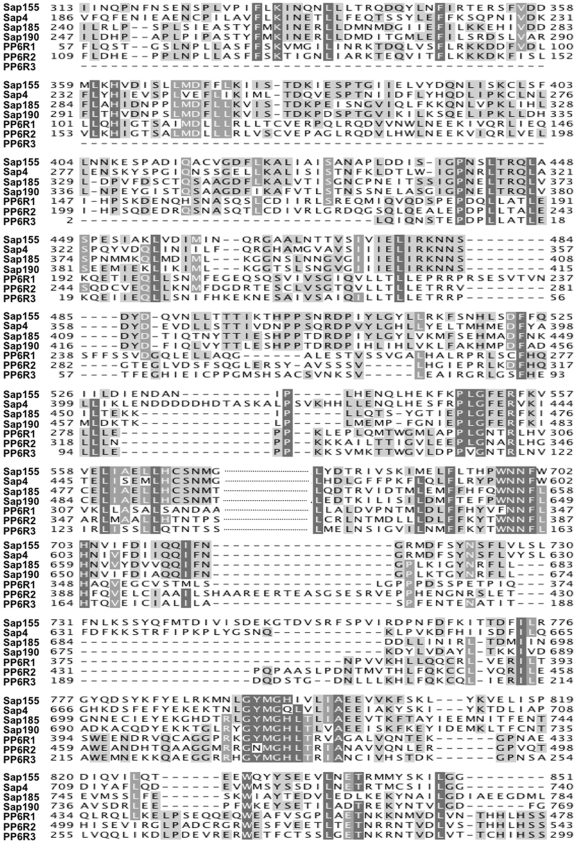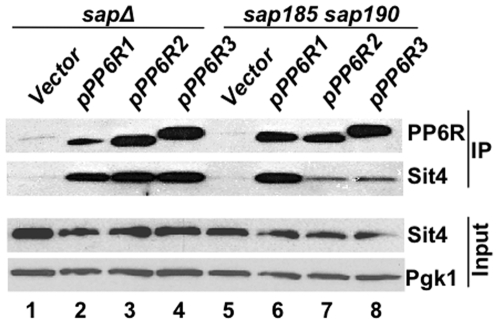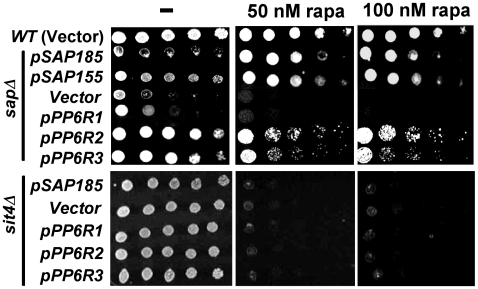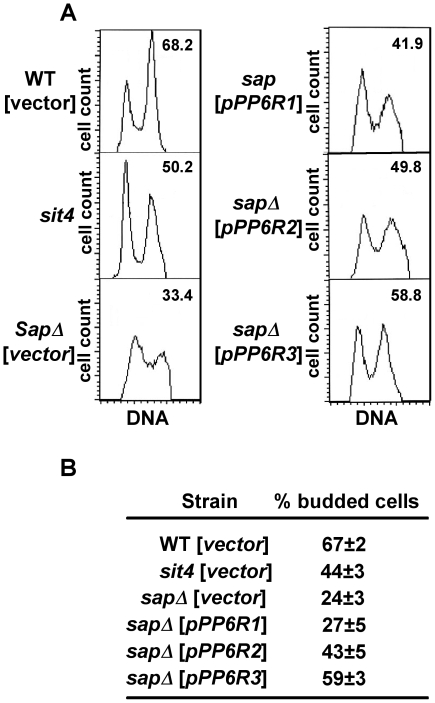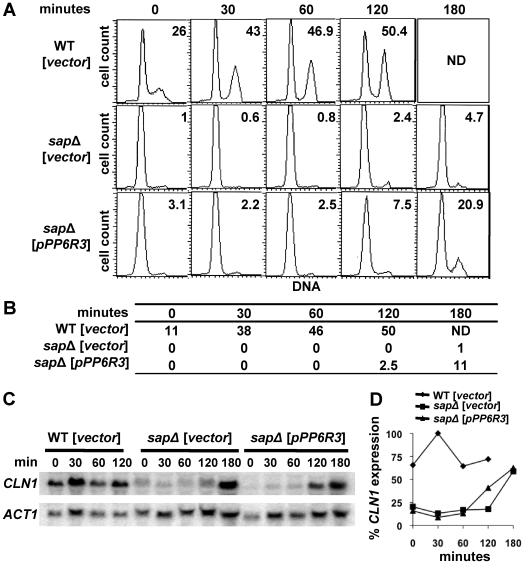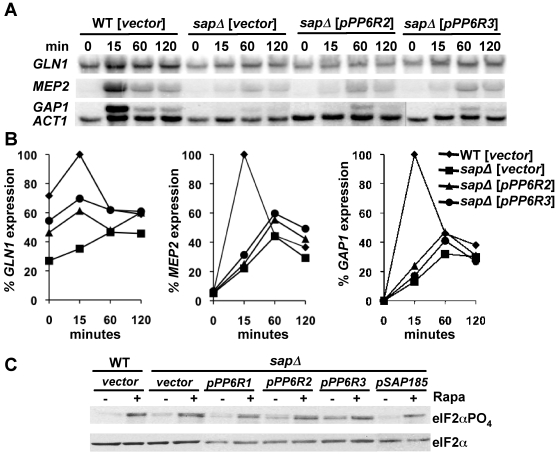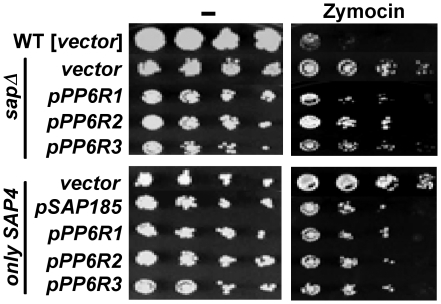Abstract
In the budding yeast Saccharomyces cerevisiae the protein phosphatase Sit4 and four associated proteins (Sap4, Sap155, Sap185, and Sap190) mediate G1 to S cell cycle progression and a number of signaling events controlled by the target of rapamycin TOR signaling cascade. Sit4 and the Sap proteins are ubiquitously conserved and their human orthologs, PP6 and three PP6R proteins, share significant sequence identity with their yeast counterparts. However, relatively little is known about the functions of the PP6 and PP6R proteins in mammalian cells. Here we demonstrate that the human PP6R proteins physically interact with Sit4 when expressed in yeast cells. Remarkably, expression of PP6R2 and PP6R3 but not expression of PP6R1 rescues the growth defect and rapamycin hypersensitivity of yeast cells lacking all four Saps, and these effects require Sit4. Moreover, PP6R2 and PP6R3 enhance cyclin G1 gene expression and DNA synthesis, and partially abrogate the G1 cell cycle delay and the budding defect of the yeast quadruple sap mutant strain. In contrast, the human PP6R proteins only modestly support nitrogen catabolite gene expression and are unable to restore normal levels of eIF2α phosphorylation in the quadruple sap mutant strain. These results illustrate that the human PP6-associated proteins are capable of providing distinct rapamycin-sensitive and Sit4-dependent Sap functions in the heterologous context of the yeast cell. We hypothesize that the human Saps may play analogous roles in mTORC1-PP6 signaling events in metazoans.
Introduction
Protein dephosphorylation is an essential enzymatic activity through which cell signaling in response to diverse cues is processed and cellular events evoked by protein phosphorylation are mechanistically reversed. In the yeast Saccharomyces cerevisiae the type 2A-like protein phosphatase catalytic subunit Sit4 functions downstream of the rapamycin-sensitive TOR complex 1 (TORC1) to govern responses to nutrients and events required for normal G1 to S phase cell cycle transition and budding [1], [2]. In response to nutrient signals TORC1 modulates interaction of Sit4 with its essential effector Tap42 and thereby regulates translation, expression of the nitrogen catabolite-repressed (NCR) and retrograde response genes, and the Pkc1 cell integrity pathway [3]–[6].
Homologs of Sit4 and Tap42, known as PP6 and alpha4, respectively have been identified in mammalian cells. Moreover, pairwise interactions between PP2A, PP6, and alpha4 have been characterized [7]. Although rapamycin-sensitive functions have been ascribed to the PP2A-alpha4 protein phosphatase, a role for the PP6-alpha4 holoenzyme in mTORC1signaling has not yet been demonstrated [8]–[10]. PP6 shares 61% amino acid sequence identity with Sit4 and functionally complements sit4 mutations in S. cerevisiae and of the Sit4 homolog ppe1 in Schizosaccharomyces pombe [11].
In addition, Sit4 also interacts with four proteins known as the Saps (Sit4 associated proteins). Because either deletion of SIT4 or all four SAP genes results in similar phenotypic consequences, including delayed G1 to S phase cell cycle progression and thereby slower growth, budding defects, and impaired NCR gene expression and Gcn2-regulated translation, it has been thought that Sit4 functions in concert with the Saps to control these cellular processes [2], [3], [5], [12]–[14]. Based on amino acid sequence identity and functional analysis, the four Saps can be classified into two distinct subgroups: Sap185 and Sap190 are more similar to each other than to Sap155 and Sap4 [12]. Also Sap185 and Sap190 share similar functions not shared with Sap155 and Sap4. Thus, Sap185 and Sap190 function together with Sit4 to provide an essential role in the absence of Bem2 (most likely in regulating the Pkc1-cell integrity pathway), and are required for eIF2α dephosphorylation and to render yeast cells sensitive to the toxin zymocin (produced by Kluyveromyces lactis) [5], [6], [12], [15]. Moreover, Sap155 and Sap185 perform distinct, albeit in this case opposite, functions in K+ efflux regulation [16]. Finally, Sap185, Sap190, or Sap155 are individually equally effective in mediating NCR gene expression [5]. Thus, based on these criteria Sap4 is less functionally effective than the other three Saps and, similar to cells lacking the four Saps, cells expressing only Sap4 (sap155 sap185 sap190 triple mutant cells) grow poorly, show defects in NCR gene expression, and are hypersensitive to rapamycin and resistant to zymocin [1], [5], [15]. These and other genetic data are consistent with a model in which the Sap proteins act positively and in combination with Sit4 to regulate phosphatase activity, substrate specificity, or both [5], [6], [12], [15].
Recently, combined sequence and biochemical analysis uncovered Sap homologs in diverse organisms including other fungi, amphibians, worms, plants, flies, and metazoans, underscoring a potentially widespread biological conservation of Sap function [17]. Interestingly, the three human Saps identified, named PP6R1, PP6R2, and PP6R3, were shown to physically interact with human PP6 and share limited amino acid sequence identity (10%) with the four yeast Saps [17]. PP6R1 and PP6R3 share nearly identical tissue distribution, and are enriched in lung, spleen, and the bladder whereas PP6R2 is mainly present in bladder. Subsequently, it was shown that PP6, together with a PP6R and an Ankyrin repeat subunit, forms holoenzyme trimers that effectively interact with ΙκΒε in response to TNFα [17], [18]. These results are consistent with a role for PP6-PP6R complexes in limiting NF-κβ signaling; however, little else is known about PP6Rs function and any involvement in mTor signaling has not as yet been demonstrated.
In this study we have examined if the human PP6R proteins are functional Sap homologs by testing their ability to provide Sap function in S. cerevisiae. We find that human PP6R2, PP6R3, and to a lesser extent PP6R1, are stably expressed and physically interact with Sit4 in yeast cells. Expression of the individual PP6R2 and PP6R3 proteins rescued the growth defect and rapamycin hypersensitivity of yeast cells lacking all four Saps in a Sit4-dependent fashion. Sit4 and the Sap proteins function in G1 to promote timely DNA replication and bud formation [2], [12]. Both PP6R2 and PP6R3 but not PP6R1 partially provided these G1 functions when expressed in the quadruple sap mutant strain. In addition, the human PP6R proteins have a modest effect in restoring NCR gene expression in response to rapamycin treatment in cells devoid of the Saps. In contrast, none of the human PP6Rs were capable of restoring normal eIF2α phosphorylation levels in either a quadruple sap mutant or a sap185 sap190 double mutant strain. PP6R2 and PP6R3 partially restored zymocin sensitivity to cells lacking Sap185 and Sap190. Taken together, these results illustrate that the PP6-associated proteins are capable of providing distinct rapamycin-sensitive, Sit4-dependent Sap functions in yeast cells. By extension, we hypothesize that the human Saps may play related roles in TORC1-PP6 signaling events in metazoans.
Results
The human PP6R proteins are stably expressed in yeast cells and physically interact with Sit4
PP6 and Sit4 share a high degree of amino acid sequence identity; however, the PP6R proteins exhibit limited identity with the yeast Saps (Figure 1). This homology is largely confined to the SAPS domain (as defined by the Protein families database of alignments - Pfam), a central four hundred amino acid region containing several discrete, common motifs with the ability to form α helices [17]. The striking conservation between the yeast Saps and the PP6R proteins prompted us to explore the functions of the PP6R proteins in yeast cells. To this end, FLAG epitope-tagged versions of PP6R1, PP6R2, and PP6R3 were PCR amplified from previously published pcDNA3-FLAG constructs [17], placed under the control of the ADH1 constitutive promoter in the centromeric pRS416-ADH vector, and expressed in yeast cells lacking the four SAP genes. All three PP6R proteins were effectively expressed as detected by immunoprecipitation and western blot analysis; however, PP6R2 and PP6R3 were expressed at a higher level than PP6R1 (compare lanes 2–4 in Figure 2).
Figure 1. The human PP6R and the yeast Saps proteins share marked homology within the SAPS domain.
The protein sequences of the SAPS domain of Saccharomyces cerevisiae Saps and Homo sapiens PP6Rs were aligned using Jalview. Amino acid conservation is highlighted with grey boxes where the darkest grey indicates the highest level of similarity. Dashed line denotes non-homologous region.
Figure 2. PP6R proteins associate with the PP2A-like phosphatase catalytic subunit Sit4.
The quadruple sap mutant (JRY40) and sap185 sap190 double mutant (JRY29) strains were transformed with vector and derivatives expressing N-terminal FLAG tagged versions of PP6R1, PP6R2 and PP6R3. Proteins were immunoprecipitated with anti-FLAG antibody and analyzed by western blotting. The membrane was stripped and interaction with Sit4 was detected by reprobing with a Sit4 specific antiserum. Sit4 was also detected in equivalent amounts of protein extracts and Pgk1 served as a loading control.
Because all characterized Sap functions are known to require Sit4, it was therefore important to examine if the PP6R proteins interact with Sit4. As shown in Figure 2 (lanes 2–4), PP6R1, PP6R2, and PP6R3 effectively co-immunoprecipitated with Sit4 when expressed in the quadruple sap mutant. Interestingly, whereas the PP6R1-Sit4 interaction was robust in the sap185 sap190 double mutant, which still expresses Sap155 and Sap4, the PP6R2 and PP6R3-Sit4 interactions in this strain were reproducibly weaker than those observed in the quadruple sap mutant (Figure 2, lanes 6–8). These results suggest that PP6R1 competes more effectively than PP6R2 and PP6R3 with Sap155 for Sit4 interaction. This is in accord with previous observations that the Sap proteins compete with each other for Sit4 binding and that Sap155 outcompetes the other Saps in this function [12], [19] (and see further evidence below).
Human PP6R proteins support growth and abrogate rapamycin hypersensitivity of Sap-defective yeast mutants
S. cerevisiae mutant cells lacking the four SAP genes grow poorly and are hypersensitive to the Tor inhibitor rapamycin. To investigate if the PP6R proteins can provide Sap function in yeast, we tested their ability to suppress these mutant phenotypes. Strikingly, similar to expression of Sap185 and Sap155, expression of PP6R2 and PP6R3 but not PP6R1 greatly improved the growth of the quadruple sap mutant strain and moreover, restored the rapamycin sensitivity of these cells to a level comparable to that observed in the WT strain (Figure 3). In contrast, expression of either Sap185 or the PP6R proteins in a sit4 deleted strain, which also exhibits severe growth defect and rapamycin hypersensitivity, failed to mitigate either phenotype. These results demonstrate that the PP6R effects on cell growth and rapamycin sensitivity are Sit4-dependent (Figure 3). Intriguingly, the expression of PP6Rs failed to alleviate the rapamycin hypersensitivity characteristic of sap185 sap190 double mutant cells (Figure 3). This result correlates well with the observation that PP6R2 and PP6R3 are not effective in competing with Sap155 and Sap4 for Sit4 binding and suggest that, despite the robust PP6R1-Sit4 interaction, PP6R1 is unable to provide Sap function (Figure 2). These data illustrate that the PP6R2 and PP6R3 proteins are capable of supporting Sap-Sit4-dependent growth and can provide rapamycin-sensitive function in a Sit4-dependent fashion in yeast cells.
Figure 3. PP6R2 and PP6R3 rescue the growth defect and rapamycin hypersensitivity of yeast cells lacking all SAPs.
Isogenic WT (MLY41) strain transformed with vector, quadruple sap (JRY40), sit4 (SCY94) and sap185 sap190 (JRY29) mutant strains transformed with vector and plasmids expressing SAP185, SAP155, PP6R1, PP6R2, and PP6R3 were grown overnight in SD-Ura medium. Equivalent numbers of cells were serially diluted, and aliquots were spotted onto SD-Ura plates containing drug vehicle or 50 nM and 100 nM rapamycin. After 3 days of incubation at 30°C, the plates were photographed.
PP6R2 and PP6R3 can partially promote G1 progression through DNA replication and bud formation
Sit4 is required for cell cycle transition from late G1 phase to S phase [2], [20]. Deletion of the SIT4 gene or deletion of the four SAP genes results in slow growth with a large population of unbudded cells and an increase in the number of cells with a 1N DNA content, characteristic of a G1 cell cycle arrest [12], [20]. This prompted us to examine whether the PP6R proteins act by reversing the G1 cell cycle arrest of the quadruple sap mutant. We note that asynchronous cells from the quadruple sap mutant of the ∑1278b background have a tendency to aggregate, complicating cell sorting by FACS analysis. However, despite this limitation we reproducibly observed an increase in the number of cells containing 2N DNA (1.5- and 1.8-fold, respectively) when PP6R2 and PP6R3, but not PP6R1, were expressed in the quadruple sap mutant (Figure 4). This result is in agreement with the observed failure of PP6R1 to overcome the growth defect of cells lacking the four Saps (Figure 2).
Figure 4. PP6R proteins partially overcome the G1 delay and budding defects of quadruple sap mutant cells.
Isogenic WT (MLY41) and sit4 (SCY94) strains transformed with vector, and quadruple sap (JRY40) mutant strain transformed with vector and plasmids expressing PP6R1, PP6R2 and PP6R3 were grown to exponential phase and prepared for flow cytometry analysis. The plots show cell count (vertical axis) versus fluorescence intensity, which is proportional to DNA content (horizontal axis). The percentage of cells with 2N DNA content is shown in the upper right corner of each panel. (B) Table shows the percentage of budded cells, which was determined in cell cultures used for the flow cytometry. Results shown are representative of three independent experiments.
The increased 1N DNA content of the sit4 and the quadruple sap mutant strains is associated with a large fraction of unbudded cells in exponentially growing cultures [12], [20]. To investigate if the PP6R proteins promote budding, we monitored the percentage of budded cells in exponentially growing cultures of the quadruple sap mutant strain expressing these proteins. Unlike PP6R1, expression of PP6R2 and PP6R3 resulted in an increase (1.8- and 2.5-fold, respectively) in the fraction of budded cells (Figure 4B).
The Sit4 and Sap proteins are also required for normal expression of G1 cyclins [2], [12]. To further study the effect of PP6R3 expression on Sit4 functions in cell cycle progression, we monitored bud emergence and the induction of G1 cyclins in synchronized cultures. To this end, G1-phase daughter cells from the wild-type and quadruple sap mutant were collected by centrifugal elutriation and cells were allowed to progress through the cell cycle. Saccharomyces cerevisiae cells are best sorted by centrifugal elutriation when grown in media containing sucrose as the sole carbon source (D.J. Lew, personal communication). However, we found that the quadruple sap mutant cells grow very poorly in sucrose media. To obviate this limitation we grew the cells in dextrose containing media. Under these growth conditions, elutriation of the WT strain yielded an enrichment of 74% of cells with a 1N DNA content, whereas elutriation of the quadruple sap mutant mostly resulted in cells with a 1N DNA content (see panels for zero time points in Figure 5A). Upon incubation of elutriated G1-cells in fresh media an increase in CLN1 expression was observed when wild-type cells resumed growth as expected (Figure 5C and 5D). Interestingly, whereas cells transformed with the vector alone showed CLN1 expression at the 3 hr time point, expression of PP6R3 resulted in an earlier and increased expression of CLN1 at the 2 hr time point (Figure 5C and 5D). These results correlated with a four-fold increase in the percentage of PP6R3 expressing-cells with a 2N DNA content (∼21%) compared to the quadruple sap mutant cells transformed with vector alone (4.7%) (Figure 5A). In accord with this result, we also observed an increase in the budding index of the quadruple sap mutant cells expressing PP6R3 (11%) versus cells transformed with vector (1%) (Figure 5B). Taken together, these data show that PP6R2 and PP6R3 are able to promote G1 progression in yeast cells whereas PP6R1 is not.
Figure 5. PP6R3 partially enhances CLN1 expression and cell cycle progression.
Isogenic WT (MLY41) and quadruple sap (JRY40) mutant strains transformed with vector or plasmid expressing PP6R3 were grown to exponential phase and elutriated to enrich for G1 cells. Elutriated cells were collected, transferred to fresh SD-Ura media, and samples were taken over a 3 hours period for G1 functions analysis. (A) Samples were analyzed for DNA content by flow cytometry as in Figure 4A. The percentage of cells with 2N DNA content is shown in the upper right corner of each panel). (B) Table shows the percentage of budded cells (ND, not detectable). (C) CLN1 and ACT1 mRNA expression was assessed by northern blot. (D) Northern blot signals from experiment shown in Panel C for CLN1 were quantified and normalized to the ACT1 loading control signal. Results shown are the relative percentage of gene expression with maximal level of expression at 30 min for WT as 100%.
The human PP6R proteins support a modest level of NCR gene expression but fail to promote eIF2α dephosphorylation
We have previously shown that expression of the NCR genes in response to either rapamycin treatment or ammonium limitation requires Sit4 and one of the Sap proteins. Sap155, Sap185, or Sap190 alone are equally effective; however, Sap4 is unable to support this function [5]. The yeast sap quadruple mutant individually expressing PP6R2 and PP6R3 was treated with rapamycin for various periods of time. In agreement with previous results, in wild type cells (transformed with the vector control) rapamycin triggered the expression of the NCR genes GLN1, MEP2, and GAP1 and rapamycin treatment largely failed to activate these genes in the quadruple sap yeast mutant transformed with the vector alone (Figure 6A and 6B). Expression of PP6R2 and PP6R3 resulted in a modest and delayed NCR gene expression (Figure 6A and 6B), indicating that despite effective interaction with Sit4 these human Sap proteins are only modestly effective in providing the Sit4-dependent function required for the NCR response.
Figure 6. PP6R2 and PP6R3 fail to restore normal levels of NCR response in cells lacking all SAP genes.
(A) Exponentially growing cultures of the quadruple sap mutant strain (JRY40) transformed with vector or its derivatives expressing PP6R2 and PP6R3 were treated with rapamycin over a 2 hr period. RNA was isolated at the indicated time points GLN1, MEP2, GAP1and ACT1 mRNA expression levels were assayed by northern blot. (B) Northern blot signals from Panel A were quantified and normalized to the ACT1 loading control signal. Results shown are the relative percentage of gene expression with maximal level of expression at 15 min as 100%. (C) PP6R proteins fail to restore normal levels of eIF2α dephosphorylation to the quadruple sap mutant strain (JRY40). Exponentially growing cultures of isogenic WT (MLY41) strain transformed with vector, and the quadruple sap mutant (JRY40) strain transformed with vector and derivatives expressing PP6R1, PP6R2, PP6R3 and SAP185 were treated with 100 nM rapamycin for 0 or 20 min. Whole-cell extracts were prepared and analyzed by sequencial western blotting with antibodies specific for the phosphorylated and non-phosphorylated form of eIF2α.
Exposing yeast cells to amino acid starvation, nutrient limitation, or inhibition of Tor with rapamycin all result in activation of the Gcn2 kinase and initiation of the general amino acid control response [13], [14], [21]. In turn, activated Gcn2 phosphorylates and thereby inactivates the translation initiation factor eIF2α, resulting in a lower level of general translation and preferential translation of a small subset of mRNAs (such as the GCN4 mRNA), which feature multiple short open reading frames via which translation is regulated [22]. Gcn4 is a master transactivator that promotes expression of ∼400 genes, including those encoding enzymes involved in amino acid biosynthesis [23]. We have characterized a role for Sit4, Sap185, and Sap190 in maintaining a low level of phosphorylated eIF2α to promote general translation [5].
We next examined if the PP6R proteins are able to restore normal levels of eIF2α phosphorylation in quadruple sap mutant cells. As expected, eIF2α phosphorylation was increased in wild-type cells treated with rapamycin or in cells lacking the four SAP genes (Figure 6C and [5], [13]). Ectopic expression of SAP185 effectively restored the wild type level of eIF2α phosphorylation in the quadruple sap mutant, however expression of the three individual PP6R proteins failed to promote eIF2α dephosphorylation (compare control lanes without rapamycin in Figure 6C).
PP6R proteins partially mediate K. lactis toxin zymocin sensitivity in yeast sap mutants
Exposure of S. cerevisiae cells to the K. lactis toxin zymocin results in a G1 cell cycle arrest. The zymocin target is Elongator, an RNA polymerase II-associated histone acetylase multisubunit complex that facilitates PolII-dependent transcription. It has been shown that sit4 and sap mutants lacking Sap185 and Sap190 are resistant to zymocin toxicity [15]. Moreover, Sit4 in combination with Sap185 and Sap190 facilitates zymocin toxicity and acts by dephosphorylating Tot1, which is the largest subunit of the Elongator complex [19]. Zymocin is a trimeric homotoxin composed of α, β, and γ subunits. It has been hypothesized that interaction of the γ subunit with dephosphorylated Tot1 sequesters PolII, precluding transcription of key G1-S phase cell cycle regulators [19].
We tested if the mammalian PP6R subunits can substitute for Sap185 and Sap190 to restore zymocin sensitivity to sap185 sap190 mutants. While the quadruple sap, and the sap155 sap185 sap190 (expressing only SAP4) and sap4 sap155 sap185 (expressing only SAP190) triple mutant strains transformed with the vector alone were more resistant to zymocin than the wild type strain, expression of either SAP185 or any of the three PP6R genes restored zymocin toxicity, although not to the same level as that observed in the wild type strain (Figure 7). In this experiment strains were exposed to zymocin in YPD media. We note that although the PP6R proteins are being expressed from an stable maintained, centromeric plasmid, we performed control experiments in which the cells were replica-plated onto plasmid selective medium (SD-Ura) following zymocin exposure to rule out plasmid loss as a trivial explanation for these findings. These results suggest that the PP6R subunits function to mediate interaction with Sit4 targets for zymocin toxicity.
Figure 7. PP6R proteins partially restore zymocin sensitivity to the quadruple sap mutant strain.
Isogenic WT (MLY41) transformed with vector, the quadruple sap mutant (JRY40), and only SAP4 (sap155 sap185 sap190; JRY45) strains transformed with vector or constructs expressing PP6R1, PP6R2, PP6R3, or SAP185 were grown overnight in SD-Ura medium. Equivalent numbers of cells were serially diluted, and aliquots were spotted onto plates of YPD and YPD containing zymocin. After 3 days of incubation at 30°C, the plates were photographed.
Discussion
The Saps were originally identified in S. cerevisiae as Sit4 associated proteins [12], [20]. The Saps were demonstrated to function positively with Sit4 to promote G1 to S phase cell cycle progression and budding [12]. Later, it was shown that Sit4 and the Sap proteins perform a critical role downstream from the TORC1 in controlling the expression of nutrient-regulated genes and in governing Gcn2-dependent translation [5], [13], [14]. Moreover, Sit4 in conjunction with Sap185 and Sap190 is required to sensitize cells to zymocin and to counteract rapamycin toxicity [5], [15]. Sit4 and the Sap proteins have been ubiquitously conserved throughout evolution from yeast to humans. The human Sit4 ortholog PP6 is able to complement the growth defects of sit4 and pp1 mutants in budding and fission yeast, respectively [11]. However, studies to examine the role of PP6 have been hampered by the fact that PP6 knock down results in high levels of apoptosis [24]. Nonetheless, indirect evidence has suggested that the N-terminal domain of PP6 has a role in G1 cell cycle progression by influencing stabilization of cyclin D protein levels [25]. Apart from a role in limiting NF-κβ signaling, little else is known about the possible cellular functions of the PP6R proteins.
Our studies have shown that the PP6R proteins are expressed in yeast cells and are capable of physically interacting with Sit4 in cells lacking the four Sap proteins. While the observed PP6R interaction with Sit4 is robust in cells devoid of Sap proteins, this interaction is reduced for PP6R2 and PP6R3 in yeast cells expressing the endogenous Sap155 and Sap4, supporting earlier results that the Sap155-Sit4 interaction is quite stable and not subject to competition from the other yeast Saps [12]. Remarkably, PP6R2 and PP6R3 but not PP6R1 complement the growth defect of the quadruple sap yeast mutant. The growth improvement afforded by the PP6R2 and PP6R3 proteins in the quadruple sap mutant is correlated with a decrease in the fraction of cells with a 1N DNA content and concomitant increase in cells with 2N DNA content, and more efficient budding. Furthermore, PP6R3 expression is able to enhance bud emergence and CLN1 expression, and increase DNA synthesis upon growth resumption of G1-synchronized quadruple sap mutant cells. These results suggest that the PP6R proteins could perform an analogous role in combination with PP6 to promote G1 to S phase cell cycle progression as recently proposed [25]. The modest ability, or inability, of the PP6Rs to restore TORC1-governed NCR gene expression or normal eIF2α phosphorylation levels respectively, in the quadruple sap mutant cells could reflect a reduced (or lack of) ability of these proteins to interact with the effectors for these functions. Thus, the precise mechanisms by which the human PP6Rs abrogate the rapamycin hypersensitivy of the yeast quadruple sap mutant do not involve these TORC1 functions. However, rapamycin exposure of cells devoid of Sap function might impose a G1 block by more than one mechanism and an attractive model is that the PP6Rs ability to support CLN1 expression in G1 and DNA synthesis promotes G1 to S phase cell cycle progression by directly relieving one of these blocks.
Our results show that PP6R1 differs from PP6R2 and PP6R3, and fails to overcome the growth and budding defects and the rapamycin hypersensitivity observed in the quadruple sap yeast mutant. Although PP6R1 was expressed at a lower level than PP6R2 and PP6R3 in the quadruple sap mutant, it showed a robust interaction with Sit4, and was not out-competed by Sap155 in the sap185 and sap190 double mutant (Figure 2). We hypothesize that the unusually stable PP6R1-Sit4 interaction results in an inactive phosphatase and this may be the reason why PP6R1 is the least efficient of the PP6R proteins in providing Sap function when heterologously expressed in yeast. Interestingly, binding of the SV40 small t antigen to the PP2A AC dimer (thought to be tight) in place of the B regulatory subunit was shown to virtually inactivate the phosphatase towards most of its known substrates, and this effect are the basis for the oncogenic effects of small t antigen [26].
The Tor proteins were first identified in yeast via genetic analysis of rapamycin resistant mutants [27] and the mammalian mTor ortholog was later identified by biochemical approaches [28], [29]. These studies provided the foundation to define a key cellular signaling conduit that globally controls cellular physiology and growth in response to nutrients and growth factors [30]. Heterologous expression studies demonstrated that the Tor proteins are not only physically but also functionally conserved [31]. While expression of full-length mTor failed to complement yeast tor1 or tor2 mutant cells, expression of Tor1-mTor and Tor2-mTor hybrids supported Tor-dependent, rapamycin-sensitive growth of yeast cells [31]. Thus, both the FKBP12-rapamycin binding (FRB) domain and the kinase domain of mTor are fully functional in the context of the yeast cell [31]. Similarly, expression of human FKBP12 suffices to complement a yeast fpr1 mutation and restores rapamycin-sensitive cell growth [32]. Thus, all of the residues in human FKBP12 required to interact with Tor are sufficiently conserved indicating that the human FKBP12-rapamycin complex is fully proficient in binding and inhibiting the yeast Tor1 and Tor2 proteins.
The studies reported here extend this approach to define functions for the mammalian Sap protein orthologs PP6R2 and PP6R3 that appear to have been similarly conserved over the billion years of evolution separating yeast and humans from their last common ancestor. These findings suggest that PP6R1, PP6R2, and PP6R3 may play analogous mTor related signaling roles in metazoans that remain to be defined. By a similar approach recently reported by other investigators, the elements of the PI-3 kinase/PTEN/Akt cascade have been reassembled in yeast and found to provide signaling activity [33]. Thus, it may prove both technically feasible and informative to express heterologous, multi-molecular signaling circuit ensembles in the context of the yeast cell as a proxy for their functions in the much more complex milieu of the multicellular eukaryotic system.
Materials and Methods
Ethics Statement
N/A
Yeast strains, plasmids, and media
All strains used in this study are derived from wild type strain MLY41 (∑1278b background) and are listed in Table 1. Construction of SCY94, JRY29, JRY40, JRY44, and JRY45 was described earlier [5]. Plasmids pSAP185 and pSAP155 were a kindly provided by Charles DiComo. Kluyveromyces lactis strain AWJ137 was obtained from Craig Bennett (Duke University). YPD-Zymocin containing plates were prepared as previously indicated [15]. All three PP6R genes containing an N-terminal Flag tag were amplified by PCR from pcDNA3-based plasmids [17] and cloned into pRS416-ADH1 (URA3) [34] by homologous recombination [35].
Table 1. Yeast strains.
| Strain | Genotype | Source |
| S.cerevisiae | ||
| MLY41 | MAT a ura3-52 (∑1278 background) | Lorenz et al., 1997 |
| SCY94 | MAT a ura3-52 sit4::kanMX | Cutler et al., 2001 |
| JRY29 | MAT a ura3-52 sap185::hygB sap190::kanMX | Rohde et al., 2004 |
| JRY40 | MAT a ura3-52 sap4::kanMX sap155::hygB sap185::hygB sap190::kanMX | Rohde et al., 2004 |
| JRY44 | MAT a ura3-52 sap4::kanMX sap155::hygB sap185::hygB | Rohde et al., 2004 |
| JRY45 | MAT a ura3-52 sap155::hygB sap185::hygB sap190::kanMX | Rohde et al., 2004 |
| K. lactis | ||
| AWJ137 | MAT a leu2 trp1 [pGK11+ pGK12+] | Kamper et al., 1991 |
Unless otherwise indicated strains were grown to exponential phase in yeast extract peptone dextrose (YEPD) or synthetic complete media. Yeast synthetic media (YNB) with ammonium sulfate was supplemented with 2% glucose. SD media was supplemented with amino acids to satisfy auxotrophic requirements. Rapamycin was added to the media from a concentrated stock solution in 90% ethanol, 10% Tween20. Yeast transformations were performed using the Lithium acetate method [36].
Amino acid sequence comparisons
Amino acid sequences of Sap155 (P43612), Sap4 (P53036), Sap185 (P40856), Sap190 (P36123), PP6R1 (Q9UPN7), PP6R2 (O75170), and PP6R3 (Q5H9R7) were obtained from the European Bioinformatics Institute (EBI, http://www.ebi.ac.uk). Sequence alignment was performed using Jalview as alignment editor [37].
Western blotting
For immunoprecipitation of FLAG tagged PP6R proteins, whole cell extracts were prepared from exponentially growing cultures of JRY40 transformed with vector alone (pRS416-ADH) or containing each of the PP6R genes N-terminally tagged with one FLAG epitope. Cells were harvested and subjected to mechanical breakage using glass beads in lysis buffer containing 20 mM KHPO4 (pH 7.2), 2 mM EDTA, 2 mM EGTA, 25 mM β-glycerophosphate, 25 mM NaF, 1 mM NaVO4, 0.5% TritonX-100, 1 mM DTT, a mixture of proteinase inhibitors (cocktail IV-Calbiochem, La Jolla, CA), and 0.5 mM phenylmethylsulfonyl fluoride [5]. To detect the PP6R proteins, 3 mg of protein extract was immunoprecipated with 30 µl of EzviewTM Red Anti-FLAG M2 Affinity Gel (Sigma) for 2 hrs at 4°C. Immunoprecipitates were washed four times with lysis buffer. Proteins extracted from immunoprecipitated beads were electrophoresed through 4–20% Novex Tris-Glycine Gels (Invitrogen), subjected to Western blot analysis, and probed with a monoclonal antibody specific for FLAG (Sigma). The blot was stripped and reprobed with a rabbit polyclonal Sit4 specific antibody (kindly provided by Yu Jiang, University of Pittsburg). Pgk1 was detected with a monoclonal antibody (Molecular Probes).
For analysis of eIF2α, 75 µg of protein were electrophoresed through 4–20% Novex Tris-Glycine Gel (Invitrogen) and subjected to Western blot analysis. To prevent the dephosphorylation of proteins 100 mM NaF was added to the blocking milk solution. Blots were probed with an antibody specific to the phosphorylated Ser51 residue of eIF2α (BIOSOURCE International). Blots were stripped and reprobed with an anti-Sui2 antibody (a generous gift of A. Hinnebusch) to detect the eIF2α non-phosphorylated isoform.
Flow cytometry, budding index, and cell cycle synchrony
Flow cytometry analysis were performed as previously described [38]. Cells were harvested at OD600 of 0.4, fixed overnight in 70% ethanol, washed with water, and incubated with 2 mg/ml RNase A (Sigma) in 50 mM Tris-HCl (pH 8.0) for 3 hrs at 37°C. Cells were washed and treated with 5 mg/ml pepsin (Sigma) in 0.45% HCl (vol/vol) for 15 min. DNA was stained with Sytox Green (Invitrogen) in 50 mM Tris-HCl (pH 7.5) and cells were briefly sonicated to separate clumped cells prior to FACS analysis. DNA content of 10,000 cells was measured with a Becton Dickinson FACSCalibur and analyzed with CellQuest software (Becton Dickinson Biosciences, San Jose, CA). The percentage of budded cells was determined as previously described [12] by counting at least 400 cells for each of three independent cultures.
For cell cycle synchronization studies, cells were elutriated as described [39]. Briefly, 1–2 liters of cells were grown at 30°C in SD-Ura to an OD600 of 0.8, chilled to 4°C, and sonicated to disperse clumps. The cells were loaded into an elutriator rotor (Beckman Instruments) and centrifuged at 4,000 rpm for 1 hr at 4°C. The fraction enriched in G1 cells was collected in bottles on ice, concentrated by centrifugation, resuspended in fresh SD-Ura media at OD600 0.4, and incubated at 30°C for various times.
Northern Blot Analysis
Yeast strains were grown overnight in SD-Ura medium to exponential phase (OD600 of 0.6–0.8). 100 nM rapamycin was added to the cultures and cells were harvested at various time points. RNA isolation and northern blot analysis were performed as previously described [40] and specific signals were quantified with a Typhoon 9200 variable mode imager using the Image Quantifier 5.2 software (Molecular Dynamics).
Acknowledgments
We are grateful to Alan Hinnebusch and Yu Jiang for generous gifts of antisera, Craig Bennett for strains, and Charles DiComo for plasmids. We thank Lukasz Kosubowski for advice and assistance with cell elutriation, Daniel Lew for sharing elutriation equipment, and Joseph Heitman for critical reading of the manuscript.
Footnotes
Competing Interests: The authors have declared that no competing interests exist.
Funding: This work was supported by R01 award CA114107 from the NCI (to M. E. C) and by R01 award CA40024 (to D.L.B.). The funders had no role in study design, data collection and analysis, decision to publish, or preparation of the manuscript.
References
- 1.Di Como CJ, Arndt KT. Nutrients, via the Tor proteins, stimulate the association of Tap42 with type 2A phosphatases. Genes Dev. 1996;10:1904–1916. doi: 10.1101/gad.10.15.1904. [DOI] [PubMed] [Google Scholar]
- 2.Fernandez-Sarabia MJ, Sutton A, Zhong T, Arndt KT. SIT4 protein phosphatase is required for the normal accumulation of SWI4, CLN1, CLN2, and HCS26 RNAs during late G1. Genes Dev. 1992;6:2417–2428. doi: 10.1101/gad.6.12a.2417. [DOI] [PubMed] [Google Scholar]
- 3.Beck T, Hall MN. The TOR signalling pathway controls nuclear localization of nutrient-regulated transcription factors. Nature. 1999;402:689–692. doi: 10.1038/45287. [DOI] [PubMed] [Google Scholar]
- 4.Bertram PG, Choi JH, Carvalho J, Ai W, Zeng C, et al. Tripartite regulation of Gln3p by TOR, Ure2p, and phosphatases. J Biol Chem. 2000;275:35727–35733. doi: 10.1074/jbc.M004235200. [DOI] [PubMed] [Google Scholar]
- 5.Rohde JR, Campbell S, Zurita-Martinez SA, Cutler NS, Ashe M, et al. TOR controls transcriptional and translational programs via Sap-Sit4 protein phosphatase signaling effectors. Mol Cell Biol. 2004;24:8332–8341. doi: 10.1128/MCB.24.19.8332-8341.2004. [DOI] [PMC free article] [PubMed] [Google Scholar]
- 6.Torres J, Di Como CJ, Herrero E, De La Torre-Ruiz MA. Regulation of the cell integrity pathway by rapamycin-sensitive TOR function in budding yeast. J Biol Chem. 2002;277:43495–43504. doi: 10.1074/jbc.M205408200. [DOI] [PubMed] [Google Scholar]
- 7.Chen J, Peterson RT, Schreiber SL. Alpha4 associates with protein phosphatases 2A, 4, and 6. Biochem Biophys Res Commun. 1998;247:827–832. doi: 10.1006/bbrc.1998.8792. [DOI] [PubMed] [Google Scholar]
- 8.Murata K, Wu J, Brautigan DL. B cell receptor-associated protein alpha4 displays rapamycin-sensitive binding directly to the catalytic subunit of protein phosphatase 2A. Proc Natl Acad Sci U S A. 1997;94:10624–10629. doi: 10.1073/pnas.94.20.10624. [DOI] [PMC free article] [PubMed] [Google Scholar]
- 9.Kong M, Bui TV, Ditsworth D, Gruber JJ, Goncharov D, et al. The PP2A-associated protein alpha4 plays a critical role in the regulation of cell spreading and migration. J Biol Chem. 2007;282:29712–29720. doi: 10.1074/jbc.M703159200. [DOI] [PubMed] [Google Scholar]
- 10.Krauss S, Foerster J, Schneider R, Schweiger S. Protein phosphatase 2A and rapamycin regulate the nuclear localization and activity of the transcription factor GLI3. Cancer Res. 2008;68:4658–4665. doi: 10.1158/0008-5472.CAN-07-6174. [DOI] [PubMed] [Google Scholar]
- 11.Bastians H, Ponstingl H. The novel human protein serine/threonine phosphatase 6 is a functional homologue of budding yeast Sit4p and fission yeast ppe1, which are involved in cell cycle regulation. J Cell Sci. 1996;109 (Pt 12):2865–2874. doi: 10.1242/jcs.109.12.2865. [DOI] [PubMed] [Google Scholar]
- 12.Luke MM, Della Seta F, Di Como CJ, Sugimoto H, Kobayashi R, et al. The SAP, a new family of proteins, associate and function positively with the Sit4 phosphatase. Mol Cell Biol. 1996;16:2744–2755. doi: 10.1128/mcb.16.6.2744. [DOI] [PMC free article] [PubMed] [Google Scholar]
- 13.Cherkasova VA, Hinnebusch AG. Translational control by TOR and TAP42 through dephosphorylation of eIF2α kinase Gcn2. Genes Dev. 2003;17:859–872. doi: 10.1101/gad.1069003. [DOI] [PMC free article] [PubMed] [Google Scholar]
- 14.Kubota H, Obata T, Ota K, Sasaki T, Ito T. Rapamycin-induced translational derepression of GCN4 mRNA involves a novel mechanism for activation of the eIF2 alpha kinase Gcn2. J Biol Chem. 2003;278:20457–20460. doi: 10.1074/jbc.C300133200. [DOI] [PubMed] [Google Scholar]
- 15.Jablonowski D, Butler AR, Fichtner L, Gardiner D, Schaffrath R, et al. Sit4p protein phosphatase is required for sensitivity of Saccharomyces cerevisiae to Kluyveromyces lactis zymocin. Genetics. 2001;159:1479–1489. doi: 10.1093/genetics/159.4.1479. [DOI] [PMC free article] [PubMed] [Google Scholar]
- 16.Manlandro CM, Haydon DH, Rosenwald AG. Ability of Sit4p to promote K+ efflux via Nha1p is modulated by Sap155p and Sap185p. Eukaryot Cell. 2005;4:1041–1049. doi: 10.1128/EC.4.6.1041-1049.2005. [DOI] [PMC free article] [PubMed] [Google Scholar]
- 17.Stefansson B, Brautigan DL. Protein phosphatase 6 subunit with conserved Sit4-associated protein domain targets IkappaBepsilon. J Biol Chem. 2006;281:22624–22634. doi: 10.1074/jbc.M601772200. [DOI] [PubMed] [Google Scholar]
- 18.Stefansson B, Ohama T, Daugherty AE, Brautigan DL. Protein phosphatase 6 regulatory subunits composed of ankyrin repeat domains. Biochemistry. 2008;47:1442–1451. doi: 10.1021/bi7022877. [DOI] [PubMed] [Google Scholar]
- 19.Jablonowski D, Fichtner L, Stark MJ, Schaffrath R. The yeast elongator histone acetylase requires Sit4-dependent dephosphorylation for toxin-target capacity. Mol Biol Cell. 2004;15:1459–1469. doi: 10.1091/mbc.E03-10-0750. [DOI] [PMC free article] [PubMed] [Google Scholar]
- 20.Sutton A, Immanuel D, Arndt KT. The Sit4 protein phosphatase functions in late G1 for progression into S phase. Mol Cell Biol. 1991;11:2133–2148. doi: 10.1128/mcb.11.4.2133. [DOI] [PMC free article] [PubMed] [Google Scholar]
- 21.Hinnebusch AG, Natarajan K. Gcn4p, a master regulator of gene expression, is controlled at multiple levels by diverse signals of starvation and stress. Eukaryot Cell. 2002;1:22–32. doi: 10.1128/EC.01.1.22-32.2002. [DOI] [PMC free article] [PubMed] [Google Scholar]
- 22.Hinnebusch A. Mechanism and regulation of initiator methionyl-tRNA binding to ribosomes. In: Sonenberg NJWBH, Mathews MB, editors. Cold Spring Harbor, N.Y.: Cold Spring Harbor Laboratory Press; 2000. pp. 185–243. [Google Scholar]
- 23.Natarajan K, Meyer MR, Jackson BM, Slade D, Roberts C, et al. Transcriptional profiling shows that Gcn4p is a master regulator of gene expression during amino acid starvation in yeast. Mol Cell Biol. 2001;21:4347–4368. doi: 10.1128/MCB.21.13.4347-4368.2001. [DOI] [PMC free article] [PubMed] [Google Scholar]
- 24.MacKeigan JP, Murphy LO, Blenis J. Sensitized RNAi screen of human kinases and phosphatases identifies new regulators of apoptosis and chemoresistance. Nat Cell Biol. 2005;7:591–600. doi: 10.1038/ncb1258. [DOI] [PubMed] [Google Scholar]
- 25.Stefansson B, Brautigan DL. Protein phosphatase PP6 N terminal domain restricts G1 to S phase progression in human cancer cells. Cell Cycle. 2007;6:1386–1392. doi: 10.4161/cc.6.11.4276. [DOI] [PubMed] [Google Scholar]
- 26.Yang S-I, Lickteig RL, Estes R, Rundell GW, Mumby MC. Control of protein phosphatase 2A by the simian virus 40 small-t antigen. Mol Cell Biol. 1991;11:1988–1995. doi: 10.1128/mcb.11.4.1988. [DOI] [PMC free article] [PubMed] [Google Scholar]
- 27.Heitman J, Movva NR, Hall MN. Targets for cell cycle arrest by the immunosuppressant rapamycin in yeast. Science. 1991;253:905–909. doi: 10.1126/science.1715094. [DOI] [PubMed] [Google Scholar]
- 28.Sabatini DM, Erdjument-Bromage H, Lui M, Tempst P, Snyder SH. RAFT1: a mammalian protein that binds to FKBP12 in a rapamycin-dependent fashion and is homologous to yeast TORs. Cell. 1994;78:35–43. doi: 10.1016/0092-8674(94)90570-3. [DOI] [PubMed] [Google Scholar]
- 29.Brown EJ, Albers MW, Shin TB, Ichikawa K, Keith CT, et al. A mammalian protein targeted by G1-arresting rapamycin-receptor complex. Nature. 1994;369:756–758. doi: 10.1038/369756a0. [DOI] [PubMed] [Google Scholar]
- 30.De Virgilio C, Loewith R. The TOR signalling network from yeast to man. Int J Biochem Cell Biol. 2006;38:1476–1481. doi: 10.1016/j.biocel.2006.02.013. [DOI] [PubMed] [Google Scholar]
- 31.Alarcon CM, Cardenas ME, Heitman J. Mammalian RAFT1 kinase domain provides rapamycin-sensitive TOR function in yeast. Genes Dev. 1996;10:279–288. doi: 10.1101/gad.10.3.279. [DOI] [PubMed] [Google Scholar]
- 32.Dolinski K, Scholz C, Muir RS, Rospert S, Schmid FX, et al. Functions of FKBP12 and mitochondrial cyclophilin active site residues in vitro and in vivo in Saccharomyces cerevisiae. Mol Biol Cell. 1997;8:2267–2280. doi: 10.1091/mbc.8.11.2267. [DOI] [PMC free article] [PubMed] [Google Scholar]
- 33.Rodriguez-Escudero I, Roelants FM, Thorner J, Nombela C, Molina M, et al. Reconstitution of the mammalian PI3K/PTEN/Akt pathway in yeast. Biochem J. 2005;390:613–623. doi: 10.1042/BJ20050574. [DOI] [PMC free article] [PubMed] [Google Scholar]
- 34.Mumberg D, Muller R, Funk M. Yeast vectors for the controlled expression of heterologous proteins in different genetic backgrounds. Gene. 1995;156:119–122. doi: 10.1016/0378-1119(95)00037-7. [DOI] [PubMed] [Google Scholar]
- 35.Ma H, Kunes S, Schatz PJ, Botstein D. Plasmid construction by homologous recombination in yeast. Gene. 1987;58:201–216. doi: 10.1016/0378-1119(87)90376-3. [DOI] [PubMed] [Google Scholar]
- 36.Schiestl RH, Gietz RD. High efficiency transformation of intact yeast cells using single stranded nucleic acids as a carrier. Curr Genet. 1989;16:339–346. doi: 10.1007/BF00340712. [DOI] [PubMed] [Google Scholar]
- 37.Clamp M, Cuff J, Searle SM, Barton GJ. The Jalview Java alignment editor. Bioinformatics. 2004;20:426–427. doi: 10.1093/bioinformatics/btg430. [DOI] [PubMed] [Google Scholar]
- 38.Haase SB, Reed SI. Improved flow cytometric analysis of the budding yeast cell cycle. Cell Cycle. 2002;1:132–136. [PubMed] [Google Scholar]
- 39.Lew DJ, Reed SI. Morphogenesis in the yeast cell cycle: regulation by Cdc28 and cyclins. J Cell Biol. 1993;120:1305–1320. doi: 10.1083/jcb.120.6.1305. [DOI] [PMC free article] [PubMed] [Google Scholar]
- 40.Cardenas ME, Cutler NS, Lorenz MC, Di Como CJ, Heitman J. The TOR signaling cascade regulates gene expression in response to nutrients. Genes Dev. 1999;13:3271–3279. doi: 10.1101/gad.13.24.3271. [DOI] [PMC free article] [PubMed] [Google Scholar]



